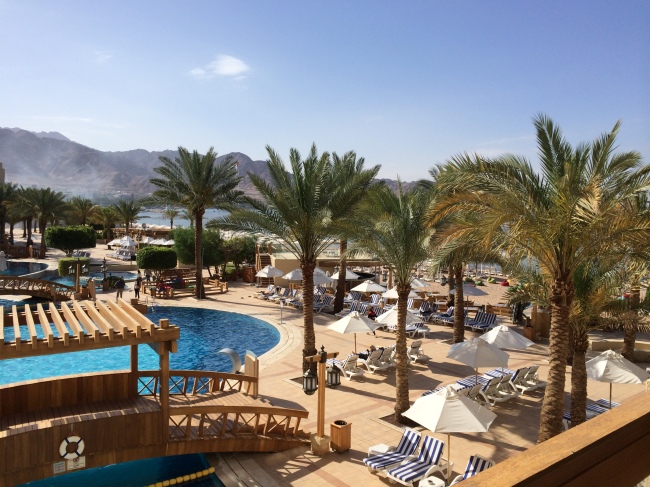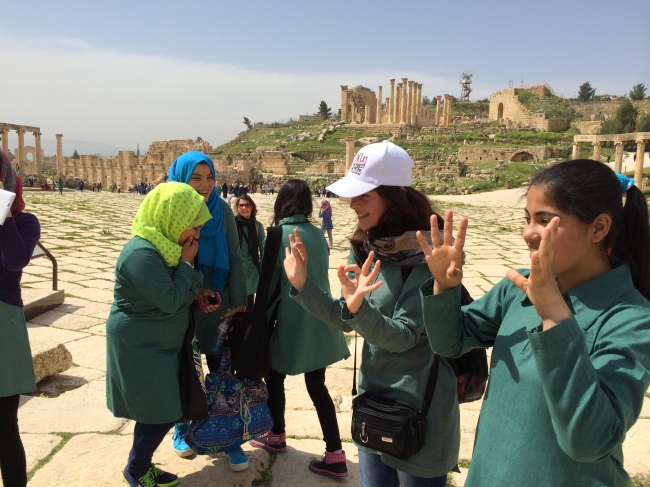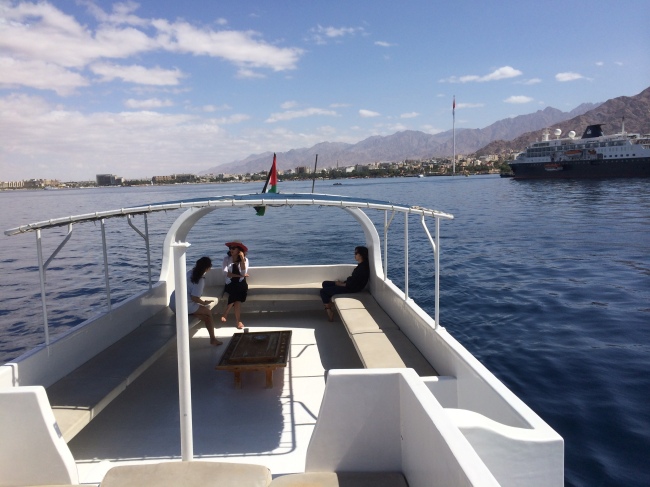AQABA, Jordan ― Jordan is well known for its archeological city, Petra, and the big salt lake, the Dead Sea, in the western part of the Middle East.
Officials from the tourism board in the country, however, noted that a large proportion of Jordanians say they love Aqaba, the only port city of Jordan, more than Petra or the Dead Sea.
The name of Aqaba, initially, reminded this reporter of Aruba on the Caribbean Sea: the latter was familiar as the first word in the lyrics of the theme song, “Kokomo,” for the Hollywood movie “Cocktail.”
Aqaba appears to be relatively be lesser known to Koreans or East Asians. But the city, like the Caribbean island Aruba, is already well known enough to be a vacation hotspot for tourists from Jordan’s neighbors, Europe and North America.
 |
| The InterContinental Resort in Aqaba |
Jordan Tourism Board managing director Abed Al Razzaq Arabiyat told reporters that U.S. citizens also make up a large portion of inbound tourists to cities including Aqaba.
It is no doubt that the “southbound” route has been a common divisor for vacationers in the northern hemisphere like some North Americans drive through to Key West in Florida. Travelers usually choose land routes from Amman to Aqaba and feel the climate changes as the latitude decreases, and the southernmost Jordanian harbor has an international airport.
Land routes to Aqaba through the desert in the Muslim country are like driving to Malibu, California, through the Nevada Desert or a trip to the African beauty of Mombasa Island across the Sahara.
 |
| Jordanian students perform the Gwiyomi song of South Korea in Jerash. |
Aqaba is like a gateway to the Red Sea and provides visitors with the peaceful scenery of the Gulf of Aqaba, which is surrounded by the territories of Jordan, Israel, Egypt and Saudi Arabia.
It was interesting to look at the Israeli side on the left and the Jordanian side on the right, while resting on a sailboat or snorkeling. A Korean traveler likened the scenic view of downtown Aqaba to that of Cebu in the Philippines.
“Aqaba is a microcosm of all the good things Jordan has to offer,” said a Tourism Board official. “It includes a fascinating history with some outstanding sites, luxurious hotels, superb shopping and residents’ hospitality.”
For those who prefer to keep their feet dry, all the deep-sea wonders can be viewed through a glass-bottomed boat or by submarine. Others can relax under the sun on the resorts’ sandy beaches. And of course, there are plenty of water-sport activities available.
Jordan attained Aqaba, which had been owned by Saudi Arabia, reportedly in exchange for a local region in the 1960s. The country, which is not a crude oil producer, later found that the relinquished territory had petroleum reserves.
 |
| Tourists enjoy the view of both Jordan and Israel on a boat in Gulf of Aqaba, which is located between the two countries and linked with the Red Sea. |
“Nevertheless, (many) Jordanians do not blame their ancestors’ deal. They rather have faithful pride in the harbor city, which attracts a number of cruise ship tourists and offers active seaborne trade,” said Kim Ji-won, a spokesperson for the Embassy of the Hashemite Kingdom of Jordan to Korea.
Aqaba International Airport is situated about 20 minutes from downtown and services regular flights from Amman, as well as from several European cities. From the town center, the borders of Israel, Egypt’s Sinai and Saudi Arabia are no more than a 30-minute drive.
Along with the port city, Jerash, a 40-minute drive from Amman, is drawing close attention from both tourists and archaeologists. The site is generally acknowledged as one of the best-preserved Roman provincial towns in the world.
Visitors can easily meet hundreds of local students on school trips and tourists from various countries in the ancient city of Jerash, which boasts an unbroken chain of human occupation dating back more than 6,500 years.
Jerash reveals a fine example of the grand, formal provincial Roman urbanism that is found throughout the Middle East, comprising paved and colonnaded streets, hilltop temples, theaters, spacious public squares and plazas, baths, fountains and city walls pierced by towers.
Countless times students, including Jordanians and those from Syria or Lebanon, asked foreigners ― including Koreans ― to take photos together. Many recited Korea’s contemporary songs and the names of actors and actresses from dramas.
The Dead Sea is famous for the lowest point on the face of the earth. This vast stretch of water receives a number of incoming rivers, including the River Jordan.
Visitors to the salty sea can also take advantage of another nearby wonder, the Ma’in Hot Springs, dubbed Hammamat Ma’in. Swimming and having a spa in the warm mineral water after sunset provide coziness and relaxation.
Popular with both locals and tourists alike, the springs are located 264 meters below sea level in one of the most breathtaking desert oases in the world. Thousands of visiting bathers come each year to enjoy the mineral-rich waters of the hyper-thermal waterfalls. The falls originate from winter rainfall in the highland plains of Jordan and feed the 109 hot and cold springs in the valley. The water is heated to temperatures of up to 63 degrees Celsius by underground lava fissures as it makes its way through the valley before emptying into the Zarqa River.
While some Koreans and other tourists are concerned about security in the Muslim country amid geopolitical instability, Arabiyat of the tourism board downplayed it.
He suggested that reporters go to restaurants and coffee shops on Rainbow Street in Amman in the evening. “If you enter the restaurants, you will see that 80 percent of the people sitting there are females. This gives the indicator that Jordan is very safe.”
He also said that “in 2014, the number of tourists from the U.S. increased by 15 percent” to post 132,000 overnight visitors from the country.
Citing 30,000 Chinese tourists last year, the board chief said China has also recently been a new attraction target for tourism.
Currently, U.S. citizens top the list of visitors to the nation, followed by Europeans and Saudi Arabians, according to the board. Even President Barack Obama visited Petra, one of the world’s newly designated seven wonders, two years ago.
By Kim Yon-se, Korea Herald correspondent (kys@heraldcorp.com)



